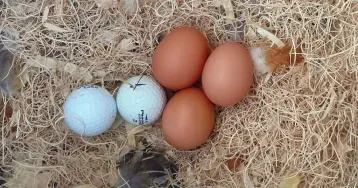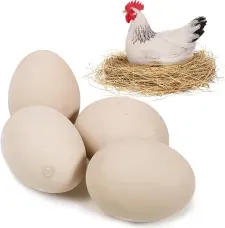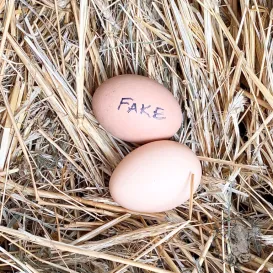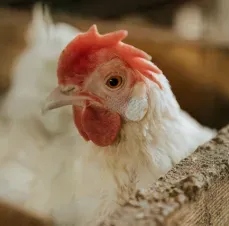The Truth Behind Fake Chicken Coop Eggs
Have you ever wondered if the eggs you buy from the supermarket are truly fresh and raised ethically?
Well, prepare to be surprised as we uncover the truth behind fake chicken coop eggs.
These counterfeit eggs, often made from plastic or other synthetic materials, have been infiltrating the market, deceiving consumers with their convincing appearance.
Join us as we take a closer look at the rise of these imposter eggs and the potential implications for both farmers and consumers alike.
Prepare to have your eyes opened to a whole new side of the egg industry.

This image is property of cluckin.net.
The Scam of Fake Chicken Coop Eggs
Imagine this: you wake up one morning, ready to cook yourself a delicious breakfast. As you crack open an egg, you notice something strange.
The shell does not the usual texture and color, and the size and shape are unusual too. Curious, you cook it and take a bite. To your disappointment, there is no distinct flavor or richness, and even the yolk looks different.
What you have just experienced is the scam of fake chicken coop eggs.
Understanding the concept of fake chicken coop eggs
Fake chicken coop eggs are precisely what their name suggests – eggs that are not laid by hens in real chicken coops.
They are a product of deception, manufactured to mimic real eggs and sold as a cheaper alternative or as a means to deceive consumers for profit.
The production of these fake eggs is a disturbing trend that undermines the trust between consumers and food suppliers.
How fake chicken coop eggs are produced
The production of fake chicken coop eggs involves a combination of synthetic materials, molds, and food-grade chemicals.
The aim is to create an egg-like appearance and texture while cutting corners on cost. These artificial eggs are then packaged and sold, often to unsuspecting consumers who are unaware of the fraud being committed.
The motivation behind producing fake chicken coop eggs
The motivation behind producing fake chicken coop eggs is primarily driven by profit. By using cheaper synthetic materials instead of real eggs, producers can save costs and maximize their earnings.
This deceptive practice not only cheats consumers out of their hard-earned money but also undermines the integrity of the food industry as a whole.
Common Signs of Fake Chicken Coop Eggs
As an educated consumer, it is crucial to be aware of the common signs that can help you identify fake chicken coop eggs. By recognizing these indicators, you can protect yourself and your family from unknowingly consuming counterfeit products.
Inconsistent shell texture and color
One of the most apparent signs of fake chicken coop eggs is the inconsistencies in shell texture and color. Real eggs have smooth, slightly uneven shells, whereas fake eggs may have a rough texture or an unnaturally glossy appearance.
Additionally, the color of the shell may vary from the usual light brown or white, with shades that are too pale or too vibrant.
Unusual size and shape
Fake chicken coop eggs often have size and shape discrepancies compared to real eggs. While natural eggs come in various sizes, fake eggs may be noticeably larger or smaller than what is typically expected.
Similarly, their shape may deviate from the familiar oval, with irregularities that are easy to spot upon closer inspection.
Shell abnormalities
Another telltale sign of fake chicken coop eggs is shell abnormalities. Real eggs have a certain level of thickness and durability, while fake eggs may be too thin or flimsy. Additionally, you may notice bumpy or misshapen areas on the shell, which are not present in authentic eggs.
Lack of distinct flavor and richness
When it comes to taste, fake chicken coop eggs often fall short. Real eggs have a unique and delicious flavor, varying slightly depending on the diet of the laying hens. However, counterfeit eggs lack this distinct flavor, often tasting bland and lacking the richness that genuine eggs possess.
False yolk appearance
The appearance of the yolk is another crucial factor in identifying fake chicken coop eggs. Real egg yolks have a vibrant yellow or orange color, and they vary in density and texture. In contrast, the yolk of a fake egg may have an unnatural hue or appear too perfect, lacking the variations and natural inconsistencies found in genuine eggs.

This image is property of i.redd.it.
Health and Safety Implications of Fake Chicken Coop Eggs
Consuming fake chicken coop eggs poses various health and safety risks that consumers need to be aware of. These risks range from potential contamination to lower nutritional value, highlighting the detrimental impact these counterfeit products can have on our well-being.
Potential contamination and foodborne illnesses
The production process of fake chicken coop eggs often lacks the stringent safety and hygiene regulations observed in legitimate egg production. As a result, these counterfeit eggs are more susceptible to contamination by bacteria, such as Salmonella.
Consuming such contaminated eggs can lead to foodborne illnesses, causing symptoms like nausea, vomiting, diarrhea, and in severe cases, even hospitalization.
Allergic reactions and sensitivities
For individuals with allergies or sensitivities to certain ingredients, consuming fake chicken coop eggs can have dire consequences.
These counterfeit eggs may contain undisclosed additives or allergens, which can trigger allergic reactions and put vulnerable individuals at risk. It is crucial for individuals with known allergies to be extra cautious and avoid purchasing and consuming suspicious eggs.
Lower nutritional value
Real eggs are known for their nutritional value, being a good source of protein, vitamins, and minerals. However, fake chicken coop eggs often lack these essential nutrients, leading to a lower overall nutritional value.
By consuming these counterfeit eggs, individuals may miss out on the health benefits associated with genuine eggs and compromise their overall well-being.
Adverse impact on consumer trust
The presence of fake chicken coop eggs in the market erodes consumer trust in the food industry. When consumers unknowingly purchase and consume counterfeit products, their trust in the food suppliers diminishes considerably.
See also Finding Forever Homes for Rescue Hens
This loss of confidence can have far-reaching consequences, affecting not only the egg industry but the entire food supply chain.
Differences Between Fake Chicken Coop Eggs and Real Eggs
To avoid falling victim to the scam of fake chicken coop eggs, it is essential to understand the key differences between these counterfeit products and real eggs. By being knowledgeable about these distinctions, you can make informed decisions when purchasing and consuming eggs.
Composition and nutritional differences
Real eggs are composed of a specific combination of proteins, lipids, and other essential nutrients that contribute to their nutritional value.
Fake chicken coop eggs, on the other hand, are made from synthetic materials and lack these natural components. This results in notable differences in taste, texture, and nutritional content between the two.
Visual and sensory distinctions
By carefully examining the appearance and sensory qualities of eggs, you can identify the differences between real and fake chicken coop eggs.
Real eggs have a natural, slightly uneven surface, while counterfeit eggs may have a smooth or overly glossy appearance. Additionally, genuine eggs have a distinct smell, while fake eggs may lack any discernible odor.
Processing and production variations
The methods used to produce real eggs versus fake chicken coop eggs differ significantly. Real eggs are produced by hens in chicken coops, which ensures a natural and organic process.
In contrast, counterfeit eggs are created in factories using synthetic materials and molds. The manufacturing process itself leads to distinct variations in appearance and quality between the two types of eggs.

This image is property of Amazon.com.
Methods to Identify Fake Chicken Coop Eggs
Detecting fake chicken coop eggs can be challenging, but there are several methods you can use to increase your chances of spotting counterfeit products.
By employing these techniques, you can protect yourself and ensure you are purchasing and consuming genuine eggs.
Conducting the float test
One simple yet effective method to identify fake chicken coop eggs is by conducting the float test. Fill a container with water and gently place the egg in it. If the egg sinks and lies horizontally on the bottom, it is most likely real.
However, if it floats or stands upright, it is a sign that the egg is fake.
Observing shell characteristics
Closely observing the shell characteristics can provide valuable insights into the authenticity of an egg. Real eggs have a slightly uneven surface, while counterfeit eggs may have a smooth or artificially glossy appearance.
Additionally, pay attention to the color and thickness of the shell, as abnormalities in these aspects can also be red flags.
Examining yolk appearance and consistency
The appearance and consistency of the yolk can help distinguish between real and fake chicken coop eggs. Real egg yolks have a vibrant color and vary in density and texture, while counterfeit egg yolks may have an unnatural hue or appear too perfect. Breaking open an egg and examining the yolk can provide essential clues.
Utilizing innovative technologies
Advancements in technology have enabled the development of innovative methods to identify fake chicken coop eggs.
Laboratory tests, such as DNA analysis or spectroscopy, can detect the presence of artificial ingredients or deviations from the natural composition of real eggs. While these methods may not be readily available to consumers, they play a significant role in identifying counterfeit eggs on a larger scale.
The Consequences of Consuming Fake Chicken Coop Eggs
The consequences of consuming fake chicken coop eggs can have severe implications for both individuals and society as a whole.
From health issues to financial burdens, it is vital to understand the potential outcomes that can arise from falling prey to this deceptive practice.
Impact on health and wellbeing
Consuming fake chicken coop eggs can lead to various health issues, ranging from foodborne illnesses to allergic reactions.
The contamination risks associated with counterfeit eggs can result in severe symptoms and, in extreme cases, even life-threatening conditions. Prioritizing your health and avoiding these fraudulent products is of utmost importance.
Loss of confidence in food suppliers
The prevalence of fake chicken coop eggs shakes consumer confidence in food suppliers. When individuals unknowingly purchase and consume counterfeit products, they feel betrayed and lose trust in the industry as a whole.
This loss of confidence can have wide-ranging effects, ultimately impacting the reputation and market stability of legitimate food suppliers.
Financial implications
From a financial standpoint, falling victim to the scam of fake chicken coop eggs can have significant implications.
Consumers who unknowingly purchase counterfeit eggs waste their hard-earned money on subpar products that do not provide the nutrition or quality they desire. This financial burden can be especially challenging for individuals or families on a tight budget.
Legal Ramifications
The production and sale of fake chicken coop eggs are illegal and punishable by law in many jurisdictions. Consumers who encounter fraudulent products should report the incident to the relevant authorities, as legal action can be taken against those involved in the production and distribution of these counterfeit eggs.
Raising awareness about these scams is crucial to protect consumers and ensure the prosecution of the perpetrators.

This image is property of downacowtrail.com.
Preventing the Production and Sale of Fake Chicken Coop Eggs
Given the detrimental consequences associated with fake chicken coop eggs, it is essential to take proactive measures to prevent their production and sale. By implementing strict regulations, educating consumers, and enhancing quality control measures, we can work towards eradicating this deceptive practice.
Strengthening regulations and enforcement
Governments and regulatory bodies must enact and enforce stringent regulations to deter the production and sale of fake chicken coop eggs.
By imposing severe penalties and conducting regular inspections, authorities can discourage individuals from engaging in this illegal activity and protect the integrity of the food industry.
See also The Welfare of Battery Hens
Educating consumers and raising awareness
Consumer education plays a crucial role in combating the issue of fake chicken coop eggs. By educating individuals about the signs and risks associated with counterfeit eggs, consumers can make informed choices and avoid falling victim to this scam.
Public awareness campaigns, online resources, and educational material can greatly contribute to raising awareness and empowering consumers.
Implementing quality control measures
Food producers and suppliers should implement robust quality control measures to ensure the authenticity and safety of their products.
Regular inspections, testing, and certification processes can help prevent fraudulent practices from infiltrating the market. By prioritizing quality control, food suppliers can guarantee that consumers receive genuine and safe eggs.
Enhancing traceability and labeling systems
By implementing advanced traceability and labeling systems, it becomes easier to track the journey of eggs from the farm to the consumer’s plate.
This transparency instills trust in the supply chain and enables consumers to verify the authenticity of products. By understanding where their eggs come from, consumers can make confident purchasing decisions and avoid counterfeit eggs.
Investigating the Fake Chicken Coop Egg Market
To combat the issue of fake chicken coop eggs effectively, it is necessary to conduct thorough investigations into the extent and implications of this illicit market.
By shedding light on the scale of the problem, identifying key players, evaluating the economic impact, and examining any potential connections to organized crime, we can develop targeted strategies to combat this fraud.
Uncovering the scale of the problem
Determining the extent of the fake chicken coop egg market requires comprehensive research and data collection.
By analyzing consumer reports, conducting undercover operations, and collaborating with law enforcement agencies, researchers can gather valuable information on the prevalence of counterfeit eggs and the scope of their distribution.
Identifying key players in the market
It is crucial to identify and target the key players involved in the production and sale of fake chicken coop eggs. This includes not only the manufacturers but also the distributors and retailers who enable the circulation of counterfeit products.
By taking legal action against these individuals and disrupting their operations, we can disrupt the supply chain and deter others from engaging in similar fraudulent activities.
Evaluating the economic impact
Understanding the economic impact of the fake chicken coop egg market is vital for developing effective strategies to combat this issue.
By analyzing the financial implications, such as lost revenue for legitimate egg producers and increased healthcare costs due to foodborne illnesses, policymakers, and industry stakeholders can justify and prioritize efforts to eradicate this illicit trade.
Examining potential connections to organized crime
The production and sale of counterfeit products often have links to organized crime networks. Examining potential connections between fake chicken coop eggs and organized crime is crucial for understanding the broader implications of this fraudulent trade.
By collaborating with law enforcement agencies and intelligence organizations, we can uncover these connections and dismantle criminal networks involved in this illicit activity.

This image is property of sp-ao.shortpixel.ai.
Consumer Tips for Avoiding Fake Chicken Coop Eggs
As a consumer, there are several tips you can follow to avoid falling victim to the scam of fake chicken coop eggs.
By incorporating these practices into your purchasing habits, you can safeguard your health, support legitimate food suppliers, and contribute to eradicating this deceptive practice.
Purchase eggs from trusted sources
To ensure the authenticity and quality of your eggs, it is advisable to purchase them from trusted sources.
Reputable grocery stores, local farmers markets, and certified organic producers are all reliable options. By establishing a relationship with these trustworthy suppliers, you can have confidence in the eggs you are purchasing.
Verify certifications and quality seals
Certifications and quality seals act as a guarantee of the authenticity and safety of eggs.
Look for prominent certifications, such as those indicating organic or free-range production methods, as they often require stringent quality control measures.
By carefully examining the packaging and verifying these certifications, you can minimize the risk of purchasing counterfeit eggs.
Learn to identify genuine eggs
Educating yourself on how to identify genuine eggs is crucial for avoiding the trap of fake chicken coop eggs. Take the time to learn about the common signs of counterfeit eggs, such as inconsistencies in shell texture and color, unusual size and shape, shell abnormalities, lack of flavor and richness, and false yolk appearance.
By being vigilant and observant, you can quickly spot suspicious eggs and refrain from purchasing them.
Support local and sustainable farming
Supporting local and sustainable farming practices is not only beneficial for the environment but also ensures the authenticity of the eggs you consume.
By purchasing eggs from local farmers who prioritize transparency and ethical practices, you can contribute to a resilient and trustworthy food system.
Additionally, by supporting sustainable farming, you can help eradicate the demand for counterfeit eggs and discourage fraudulent activities.
Conclusion
The scam of fake chicken coop eggs is a significant issue that threatens consumer health and undermines trust in the food industry. By understanding the concept of fake eggs and being aware of the common signs, individuals can protect themselves and their families from falling victim to this fraudulent practice.
The health and safety implications, as well as the consequences associated with consuming counterfeit eggs, must not be taken lightly. Authorities, food producers, and consumers must work together to combat this issue through strengthening regulations, implementing quality control measures, and raising awareness.
By prioritizing consumer health, transparency, and trust, we can ensure a future where the authenticity of our food is upheld, and scams like fake chicken coop eggs become a thing of the past.
